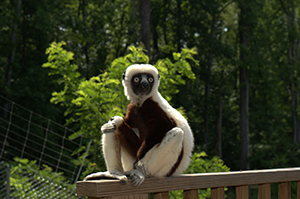The passing of Jovian, the lemur from the popular kids’ show Zoboomafoo, touched millions of people as the news spread. In the wake of Jovian’s death, DLC research intern Emma Wellbaum wrote about the loss of this special lemur and the overall challenge of protecting lemurs in Madagascar.
 December 18, 2014 — On November 10, 2014 the eighteen to twenty-five year old demographic was hit with what many consider a great loss – the death of the playful, leaping lemur named Zoboomafoo, otherwise known as Jovian by the Duke Lemur Center, who died at age twenty.
December 18, 2014 — On November 10, 2014 the eighteen to twenty-five year old demographic was hit with what many consider a great loss – the death of the playful, leaping lemur named Zoboomafoo, otherwise known as Jovian by the Duke Lemur Center, who died at age twenty.
That being said, the death of Jovian has a silver lining. It has raised awareness about the great struggle that lemurs face in today’s world. As one of humankind’s oldest known relatives, lemurs play an extremely important role in today’s primate diversity as well as the biodiversity of their native land, Madagascar.
Zoboomafoo was a PBS children’s program hosted by brothers Martin and Chris Kratt that ran from 1999-2001. The show, filmed at the Duke Lemur Center, aired 65 episodes over the short period of two years. Zoboomafoo featured a Coquerel’s sifaka lemur of the same name that jumped, leaped, and stole the hearts of thousands of children and even their parents.
In 2012, studies conducted by the International Union for Conservation and Nature (IUCN) determined that lemurs are the most endangered mammals on the planet. Out of the 103 known lemur species, 91% are threatened, and this threat has not decreased since 2012.
Deforestation in Madagascar is still the major force that jeopardizes lemurs and their habitats. With growing industry and agriculture in Madagascar, over ninety percent of lemur habitat has been destroyed by deforestation.
As stated by Russell Mittermeier in his book, The Eighth Continent, Madagascar “is only one of 92 countries with wild primate populations.” However, “it is alone responsible for twenty-one percent…of all primate families, making it the single highest priority” in regards to primate conservation.
Political instability in Madagascar has put local initiatives for protecting lemurs on the back burner. With over 60% of the population living below the poverty line, lemur habitat is being destroyed not out of financial greed, but simply in order to families to survive.
In 2009, a coup led by Andry Rajoelina left the country extremely politically polarized. However, the 2013 presidential elections, which resulted in the election of Hery Rajaonarimampianina, were a huge step forward for the country. Unfortunately, even with the progress that resulted from the elections, nothing has been done to resolve the initial and underlying causes of the 2009 coup. As Rajaonarimampianina grapples with ongoing political and social challenges, the environment has remained a low priority.
Although Jovian’s death was extremely upsetting to those of us who knew him, his passing also has had a big effect on the millions of fans of the popular television show, many of whom are now young adults ready to speak out for what they believe is important. In the wake of his loss, their attention has been brought to the vital issue of lemur conservation.
Hopefully, this newly sparked awareness and overall concern for the plight of the lemurs increases concern and social action, for it is our generation that is responsible for our world’s future. To support and learn more about this cause, please visit the Duke Lemur Center’s website, https://lemur.duke.edu, or check them out on Facebook, Twitter, and Instagram.
References:
A Cosmetic End to Madagascar’s Crisis? (2014, May 19). Retrieved November 24, 2014, from http://www.crisisgroup.org/en/regions/africa/southern-africa/madagascar/218-a-cosmetic-end-to-madagascar-s-crisis.aspx
A New Approach to Social Protection in Madagascar Empowers the Poor to Help Themselves (2014, October 28). Retrieved November 24, 2014, from http://www.worldbank.org/en/news/feature/2014/10/28/a-new-approach-to-social-protection-in-madagascar-empowers-the-poor-to-help-themselves
Dixon, A. Preservation lemur: Center raises conservation awareness (2014, October 29). Retrieved November 24, 2014, from http://www.heraldsun.com/news/localnews/x1726675240/Preservation-lemur-Center-raises-conservation-awareness
Economy of Madagascar. (n.d.). Retrieved November 24, 2014, from http://www.wildmadagascar.org/overview/economy.html
Lemurs Named World’s Most Endangered Mammals (2012, July 13). Retrieved November 24, 2014, from http://www.livescience.com/21592-madagascar-lemurs-endangered.html
Tyson, P. (2000). The eighth continent: life, death, and discovery in the lost world of Madagascar. William Morrow.
Duke University student, Emma Wellbaum, studies lemur social interactions at the Duke Lemur Center and serves as a research intern collecting valuable lemur data.


